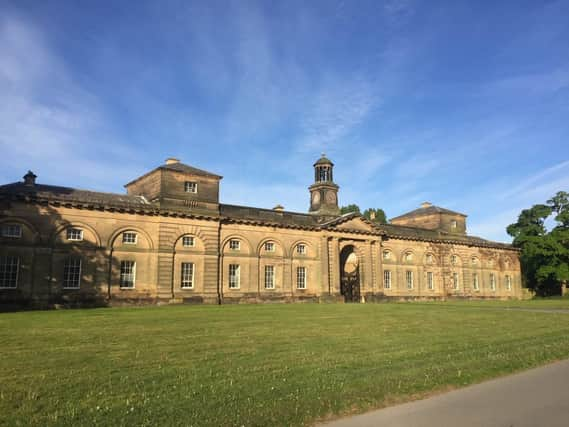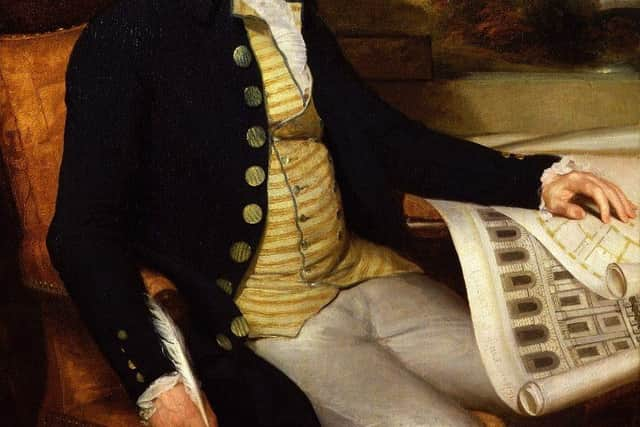Wentworth Woodhouse launches schools design challenge to celebrate 300th anniversary of John Carr, the North’s greatest 18th century architect


The hundreds of great houses, churches and public buildings he created in the 1700s were the style statements of their day.
Many still stand proudly as the 300th anniversary of his birth approaches on April 28.
Advertisement
Hide AdAdvertisement
Hide AdGrade I listed Wentworth Woodhouse in Rotherham owes much of its grandeur to Carr. To celebrate his achievements and encourage future talent, it has teamed with nationwide conservation architects Donald Insall Associates and nine other John Carr sites across the North to launch the John Carr 300 Challenge.


Donald Insalls’ architects have recreated drawings of each beautiful building - from the oldest surviving stone racecourse grandstand in the world to the iconic Crescent in Buxton - and deliberately left out one important element.
The owners of these landmark buildings are each encouraging schools in their area to study Carr’s life - and task their students with completely redesigning the missing feature.
Carr carried out numerous projects at Wentworth Woodhouse. He redesigned parts of the 606-feet long East Front, created its grand staircase, the estate’s Keppel’s Column, Needle’s Eye and Rockingham Mausoleum and the huge Stable Block.
Advertisement
Hide AdAdvertisement
Hide AdSchools will be tasked with re-designing Stable Block’s imposing central archway and clock tower.
“We want budding designers and architects of the future to let their imaginations run riot and create something exciting to go in its place. It could be strikingly modern, or influenced by architecture of the past; the choice is theirs,” said Jen Wall, Wentworth Woodhouse Preservation Trust’s Skills Development and Learning Officer.
“Our challenge celebrates the work of one of Yorkshire’s most respected sons and aims to encourage creativity and career aspirations. The Trust is passionate about helping young people through education and plans to set more design challenges for schools in the future.”
Each site will work with Donald Insalls’ architects to choose winners from educational Key Stages 1, 2 and 3 at the end of June. The best designs will go on show at each site during the national Heritage Open Days festival in September.
Advertisement
Hide AdAdvertisement
Hide AdWentworth Woodhouse’s winners will be rewarded with a specially-arranged visit for their entire class to the house and gardens, including the newly-opening Forest of Bewilderment.
Tony Barton, chairman of Donald Insall Associates, commented: “We are specialist conservation architects and are proud to have worked on some of John Carr’s magnificent buildings, including Wentworth Woodhouse’s roof, pavilions and Camellia House.
“Wouldn’t it be marvellous if this project inspires only one young person to train as a conservation architect, who works with us in the future, especially on a John Carr building, and follow in the footsteps of our brilliant trainee architects, Emma Chrystie-Lowe and Ryan Farrell, who produced the drawings for the John Carr 300 celebration?”
John Carr buildings taking part in the Challenge:
Newark Town Council - one of the finest Georgian town halls in the UK Howsham Mill - 18th century watermill near Malton North Yorkshire St Peter’s and St Leonard's Church, Horbury, Wakefield - John Carr’s resting place Buxton Crescent - Carr’s favourite work The Devonshire Dome in Buxton - originally built as The Great Stables for the 5th Duke of Devonshire in 1779 Lytham Hall in Lancashire The Stable Block - Wentworth Woodhouse stately home in Rotherham Fairfax House in York Richmond Racecourse Grandstand - the world’s oldest surviving stone-built grandstand Harewood House, Harewood, Leeds
Biography - John Carr of York
Advertisement
Hide AdAdvertisement
Hide AdJohn Carr was born in Horbury, near Wakefield, in 1723 and for over 50 years was the best known and busiest architect in the North of England.
He amassed a considerable fortune and secured a name as one of the country’s finest neoclassical architects.
On leaving school he worked as an apprentice stonemason, following in the footsteps of his father, grandfather and great-grandfather.
He taught himself architecture and was just 25 when he won a competition to design and build a new grandstand for York Racecourse.
Advertisement
Hide AdAdvertisement
Hide AdIt was admired by the ‘great and the good’ of Yorkshire, for whom he went on to design buildings.
During his career he was responsible for building, repairing or changing over 120 buildings across England, Scotland, Ireland and as far away as Portugal - including town halls, churches, bridges, racecourse grandstands, great houses - most notably Wentworth Woodhouse and Harewood House - and even prisons in Wakefield and Northallerton.
As his fame spread, his wealth grew. At his own expense, he rebuilt St Peter’s and St Leonard’s Church in his home village of Horbury and at 62 became Lord Mayor of York, the city where Carr’s impact is seen most strongly.
He and his wife Sarah remained childless but on his retirement, he took his great-nieces on trips around the country to show off his fine works.
John Carr lived his whole life in Yorkshire and died aged 83. He is buried in the graveyard of the Horbury church he designed, which is now Grade I listed and bears a monument to his life and work.